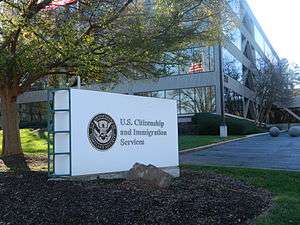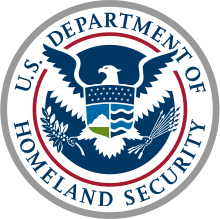United States Citizenship and Immigration Services
|
USCIS Logo | |
| Agency overview | |
|---|---|
| Formed | March 1, 2003 |
| Jurisdiction | Federal government of the United States |
| Headquarters | Washington, D.C. |
| Employees | 19,000 (2014) [1] |
| Annual budget | $3.219 billion (2014) [1] |
| Agency executives |
|
| Parent agency | United States Department of Homeland Security |
| Website | uscis.gov |
U.S. Citizenship and Immigration Services (USCIS)[2] is a component of the United States Department of Homeland Security (DHS). It performs many administrative functions formerly carried out by the former United States Immigration and Naturalization Service (INS), which was part of the Department of Justice. The stated priorities of USCIS are to promote national security, to eliminate immigration case backlogs, and to improve customer services. USCIS is headed by a director, currently Leon Rodriguez, who reports directly to the Secretary of Homeland Security.[3]
Functions

USCIS is charged with processing immigrant visa petitions, naturalization petitions, and asylum and refugee applications, as well as making adjudicative decisions performed at the service centers, and managing all other immigration benefits functions (i.e., not immigration enforcement) performed by the former INS. Other responsibilities include:
- Administration of immigration services and benefits
- Adjudicating asylum claims
- Issuing employment authorization documents (EAD)
- Adjudicating petitions for non-immigrant temporary workers (H-1B, O-1, etc.)
- Granting lawful permanent resident status
- Granting United States citizenship
While core immigration benefits functions remain the same as under the INS, a new goal is to process applications efficiently and effectively. Improvement efforts have included attempts to reduce the applicant backlog, as well as providing customer service through different channels, including the National Customer Service Center (NCSC) with information in English and Spanish, Application Support Centers (ASCs), the Internet and other channels. The enforcement of immigration laws remains under Customs and Border Protection (CBP) and Immigration and Customs Enforcement (ICE).
USCIS focuses on two key points on the immigrant's journey towards civic integration: when they first become permanent residents and when they are ready to begin the formal naturalization process. A lawful permanent resident is eligible to become a citizen of the United States after holding the Permanent Resident Card for at least five continuous years, with no trips out of the United States that last for 180 days or more. If, however, the lawful permanent resident marries a U.S. citizen, eligibility for U.S. citizenship is shortened to three years so long as the resident has been living with the spouse continuously for at least three years and the spouse has been a resident for at least three years.
Forms
USCIS handles all forms and processing materials related to immigration and naturalization. This is evident from USCIS's predecessor, the INS, (Immigration and Naturalization Service) which is defunct as of May 9, 2003.
USCIS currently handles two kinds of forms: those relating to immigration, and those related to naturalization. Forms are designated by a specific name, and an alphanumeric sequence consisting of one letter, followed by two or three digits. Forms related to immigration are designated with an I (for example, I-551, Permanent Resident Card) and forms related to naturalization are designated by an N (for example, N-400, Application for Naturalization).
Immigrations courts and judges
The United States immigration courts and immigration judges, and the Board of Immigration Appeals which hears appeals from them, are part of the Executive Office for Immigration Review (EOIR) within the United States Department of Justice. (USCIS is part of the Department of Homeland Security.)
Operations
Internet presence
USCIS' official website is USCIS.gov. The site was redesigned in 2009 and unveiled on September 22, 2009.[4]
The redesign made the web page interface more similar to the Department of Homeland Security's official website. The last major redesign before 2009 took place in October 2006.
Also, USCIS runs an online appointment scheduling service known as INFOPASS. This system allows people with questions about immigration to come into their local USCIS office and speak directly with a government employee about their case and so on. This is an important way in which USCIS serves the public. USCIS maintains a blog entitled "The Beacon" as well as the "@uscis" Twitter account.
Funding
Unlike most other federal agencies, USCIS is funded almost entirely by user fees.[5] Under President George W. Bush's FY2008 budget request, direct congressional appropriations made about 1% of the USCIS budget and about 99% of the budget was funded through fees. The total USCIS FY2008 budget was projected to be $2.6 billion.[6]
Staffing
USCIS consists of 19,000 federal employees and contractors working at 223 offices around the world.[7]
History
The INS was widely seen as ineffective, particularly after scandals that arose after September 11, 2001.[8] On November 25, 2002, President George W. Bush signed the Homeland Security Act of 2002 into law. This law transferred the Immigration and Naturalization Service (INS) functions to the Department of Homeland Security (DHS). Immigration enforcement functions were placed within the U.S. Customs and Border Protection (CBP) at the border and Ports-of-Entry while U.S. Immigration and Customs Enforcement (ICE) within land. The immigration service functions were placed into the separate USCIS. USCIS was formerly and briefly named the U.S. Bureau of Citizenship and Immigration Services (BCIS), before becoming USCIS.[9]
On March 1, 2003, the INS ceased to exist and services provided by that organization transitioned into USCIS. Eduardo Aguirre was appointed the first USCIS Director by President Bush. In December 2005, Emilio T. Gonzalez, Ph.D., was confirmed by the U.S. Senate as the Director of USCIS, and he held this position until April 2008.[10] Nominated by President Barack Obama on April 24 and unanimously confirmed on August 7 by the U.S. Senate, Alejandro Mayorkas was sworn in as USCIS Director on August 12, 2009.
See also
- Attorney General of the United States
- Immigration and Naturalization Service
- Immigration to the United States
- List of United States immigration legislation
- Naturalization
- Private bill
- U.S. Customs and Border Protection (CBP)
- U.S. Immigration and Customs Enforcement (ICE)
References
![]() This article incorporates public domain material from websites or documents of the United States Department of Homeland Security.
This article incorporates public domain material from websites or documents of the United States Department of Homeland Security.
- 1 2 "Budget-in-Brief: Fiscal Year 2015" (PDF). U.S. Department of Homeland Security. Retrieved 2014-11-12.
- ↑ https://www.uscis.gov/history-and-genealogy/our-history/our-history
- ↑ "U.S. Citizenship and Immigration Services". U.S. Citizenship and Immigration Services. Department of Homeland Security. Retrieved 1 May 2014.
- ↑ "Secretary Napolitano and USCIS Director Mayorkas Launch Redesigned USCIS Website" (Press release). United States Department of Homeland Security. September 22, 2009. Retrieved April 10, 2010.
- ↑ CIS Ombudsman's 2007 Annual Report, pages 46-47
- ↑ USCIS FY2008 budget request fact sheet
- ↑ USCIS website
- ↑ Special report "The INS's Contacts With Two September 11 Terrorists" by the U.S. DOJ Inspector General, May 20, 2002, at www.usdoj.gov
- ↑ Name Change From the Bureau of Citizenship and Immigration Services to U.S. Citizenship and Immigration Services [69 FR 60938] [FR 39-04]. Uscis.gov. Retrieved on 2013-07-23.
- ↑ Leadership info at www.uscis.gov
External links
| Wikimedia Commons has media related to United States Citizenship and Immigration Services. |
- Official website
- USCIS in the Federal Register
- Official blog
- Homeland Security Act of 2002
- USCIS INFOPASS Appointment Scheduler
- United States Immigration Trackers
- USCIS History: Major milestones of USCIS and other immigration agencies, from the 19th century to 2003
- what is USCIS by Cacfti

